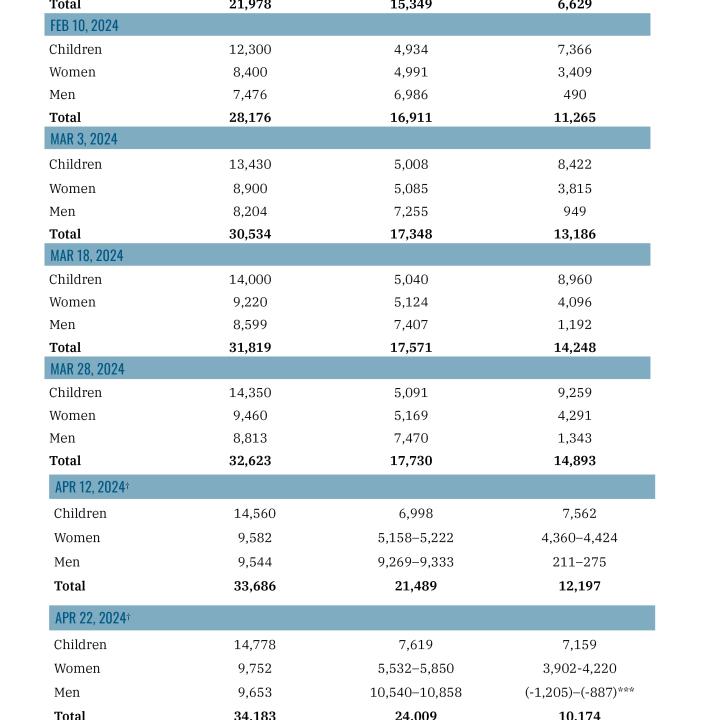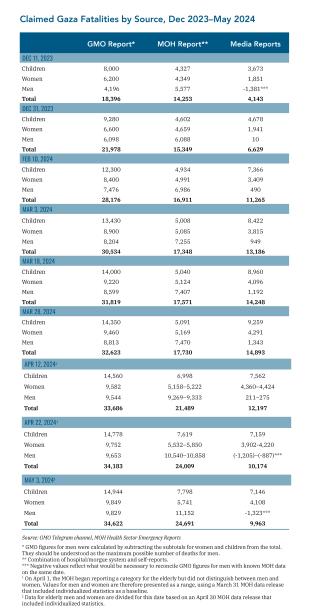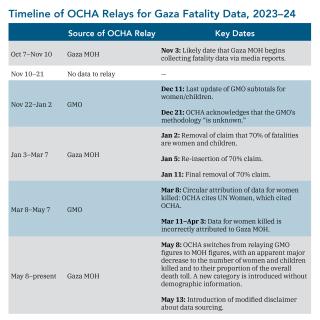
- Policy Analysis
- PolicyWatch 3871
Untangling the UN’s Gaza Fatality Data

A major shift in the death toll for women and children points to deeper problems in the way OCHA is relaying data and handling questionable sources.
Recently, news outlets and analysts noticed that the UN Office for the Coordination of Humanitarian Affairs had substantially altered the Gaza death toll it relays from Palestinian sources. Between May 6 and May 8, OCHA reports decreased the total number of women and children killed during the war by almost 47%. The organization also indicated that men age 19-59 made up 40% of the dead, contradicting previous claims that 70% were women and children.
A UN spokesman presented the changes as routine revisions and attributed the major discrepancy to the “fog of war.” Others concluded that the UN had unilaterally lowered the death toll. Yet both interpretations misunderstand how fatality data is collected and reported during the war, and how OCHA relays those claims.
Problems in the UN Relay Process
Although OCHA has attempted to verify deaths and distinguish between combatants and civilians in previous conflicts worldwide, it has not done so with the current Gaza data it receives from the Hamas-run Ministry of Health (MOH) and the Government Media Office (GMO, a subunit of the Hamas-run Ministry of Information). Instead, OCHA merely relays fatality statistics from Gaza; it does not generate or check them. Although the organization openly acknowledges this fact, its relay effort has been imperfect at best, and several of its decisions about the data it disseminates are cause for concern.
One problem is that OCHA consistently fails to acknowledge that the MOH uses three separate methodologies to count fatalities:
- The hospital and morgue system, which is well-understood and considered relatively reliable based on its reporting during previous wars
- A self-reporting system in which relatives of those killed submit data through a Google Form
- So-called “media reports,” about which very little is known
Between October 7 and November 10, OCHA reports relayed MOH claims about the number of women, children, and elderly killed, but often failed to update specific categories or treat data on elderly women consistently (see the author’s January study for more on these problems). When the MOH stopped reporting data for three weeks amid the Israeli ground invasion and collapse of the hospital system in northern Gaza, OCHA reports paused for two weeks. Afterward, OCHA began relaying GMO fatality claims from November 22 to December 11, describing the GMO as being “under the local authorities in Gaza” but incorrectly stating that it had “assumed MOH’s role” in reporting casualty figures. OCHA kept the December 11 numbers on its reports until January 2, but included a caveat in a December 21 update that the GMO’s “methodology is unknown.” It then stopped using the GMO as a source.
By mid-December, it was clear that GMO claims diverged sharply from MOH data (see table below). In a December 11 Health Sector Emergency Report (HSER), the MOH revealed that it had begun including reports from “reliable media sources” to calculate fatalities and injuries. These media sources then became the dominant input in the daily death toll, accounting for 46% of claimed fatalities by the end of March. One major problem with this approach quickly materialized. While women and children made up less than 60% of the fatalities reported by hospitals and morgues, the MOH publicly claimed that they comprised over 70% of the death toll. To reconcile these contradictory claims, at least 90% of the deaths recorded via “media reports” had to be women and children—an implausible proportion under any circumstances (see the author’s March article on this discrepancy). On March 27, the MOH dropped the 70% claim, but the GMO maintained it.
Meanwhile, OCHA inexplicably reverted to using GMO figures for women and children on March 8, even though they were disconnected from and inconsistent with MOH data. OCHA also briefly engaged in circular citations, attributing the fatality data for women to another UN agency, UN Women, who in turn cited OCHA; in reality, both were citing the GMO.
The UN’s relay of GMO data—often incorrectly identified as MOH data—persisted until May 8, when OCHA accurately relayed what the MOH was claiming for the first time in five months, resulting in a major decrease in the total reported deaths for women and children. Despite this improvement, however, problems persist.
For one, OCHA has apparently accepted the MOH’s new terminology of “identified” and “unidentified” fatalities without comment. Between December 11 and March 31, the MOH repeatedly referred to “media reports” in all of its HSERs (see here for an archive of past HSERs). Yet it changed this phrase on April 1 as questions mounted about its fatality claims, instead calling them “unidentified reports” in its daily summaries of Gaza public health issues. Tellingly, however, it retained the phrase “media reports” in the data tables that accompanied its HSERs, suggesting that this was a change in name only.
The crux of the problem with relabeling “media reports” as “unidentified” is that in many cases, there is no body to identify. When presenting claimed fatalities under this label, Palestinian reports and OCHA relays give the impression that the MOH is working through some backlog of unidentified bodies sitting in morgues. Yet the “media reports” methodology was originally established to record fatalities in places where the hospital/morgue system had gone offline—that is, these claimed fatalities never went to morgues, whether because they were privately buried, presumed to be lying under rubble, or never located. The result is substantial overlap between separate counting mechanisms and mistaken assumptions about the overall death toll.
Closer analysis of the MOH’s data casts doubt on the “identified” distinction as well. Although OCHA did not specifically source its new demographic breakdown on May 8, it closely matches a May 2 MOH release covering October 7-April 30. Yet a significant number of the fatalities that the MOH has recorded from hospitals, morgues, and self-reports are only partially identified—specifically, 17.1% of them are missing one or more key data points such as age, name, sex, or ID number (or have invalid ID numbers). This problem is only getting worse—analysis of a March 31 MOH report revealed that 15.7% of its fatality records had incomplete data.
Recommendations
To its credit, OCHA has been clear that it only relays fatality figures and does not attempt to verify them. It has also beefed up the disclaimer on its reports and moved it from the bottom of its dense data summaries—where many viewers likely overlooked it—to the top. The new disclaimer on OCHA’s “reported impact” statements reads as follows: “Figures that are yet-to-be verified by the UN are attributed to their source. Casualty numbers have been provided by the Ministry of Health or the Government Media Office in Gaza and the Israeli authorities. Previous data breakdowns provided in this snapshot of women and children killed were attributed to the GMO based on reported fatalities. The fatality breakdowns currently cited are those that the MOH in Gaza has recently fully identified out of the higher number of casualties they report.”
Yet this revision was not made until May 13—days after a major change quietly appeared in the death toll for women and children, months after questions were first raised about data from Hamas-run institutions, and more than half a year into a war in which many observers likely assumed that the UN’s published figures had been validated. Moreover, OCHA’s on-again, off-again reliance on GMO claims is highly questionable given their opaque methodology and sharp divergence from MOH claims.
A more transparent OCHA relay process would embrace the following practices:
- Avoid citing the GMO at all
- Consistently use MOH data
- Clearly explain and distinguish between the MOH’s methodologies for obtaining this data
- Sort out the MOH’s shift from “media reports” to “unidentified reports”—which does not seem like a shift at all and lends unwarranted veracity to fatalities categorized as “identified”
Too often, journalists and commentators erroneously cite GMO officials as “Gaza health authorities” and make claims that the actual Gaza health authority—the Hamas-run MOH—does not make. By relaying GMO claims, OCHA contributes to that conflation and the spread of unsupported claims.
Of course, accurately counting the dead in a chaotic conflict is a severe challenge, so all parties should be exceedingly careful when making claims about the death toll. Given their stature, OCHA and other UN bodies have a particularly deep responsibility to ensure professionalism and transparency—a duty that has not been fulfilled so far.
Gabriel Epstein is a research assistant in The Washington Institute’s Koret Project on Arab-Israel Relations.




